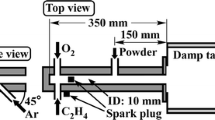Abstract
To realize kilohertz and higher frequency of a pulse detonation cycle (PDC), enhancement of deflagration-to-detonation transition (DDT) is necessary. A novel semi-valveless PDC method, in which the inner diameter of the oxidizer feed line is equal to that of the combustor, can increase the pressure of detonable mixture by increasing total pressure of supplying oxidizer. In demonstration experiments, ethylene as fuel, pure oxygen as the oxidizer and the combustor having an inner diameter of 10 mm and length of 100 or 60 mm were used. A PDC was successfully operated at the frequency of up to 1916 Hz. Under the condition of 1010 Hz operation, the total pressure of supplying oxidizer were varied. As the results, it was found that the DDT distance and time decreased by approximately 50% when the total pressure of supplying oxidizer increased by 242%.
Similar content being viewed by others
References
Ciccarelli, G., & Dorofeev, S. (2008). Flame acceleration and transition to detonation in ducts. Progress in Energy and Combustion Science, 34(4), 499–550.
Endo, T., Yatsufusa, T., Taki, S., & Kasahara, J. (2004a). Thermodynamic analysis of the performance of a pulse detonation turbine engine. Science and Technology of Energetic Materials, 65(103), 103–110. (in Japanese).
Endo, T., Kasahara, J., Matsuo, A., Inaba, K., Sato, S., & Fujiwara, T. (2004b). Pressure history at the thrust wall of a simplified pulse detonation engine. AIAA Journal, 42(9), 1921–1930.
Endo, T., Obayashi, R., Tajiri, T., Kimura, K., Morohashi, Y., Johzaki, T., Matsuoka, K., Hanafusa, T., & Mizunari, S. (2016). Thermal spray using a high-frequency pulse detonation combustor operated in the liquid-purge mode. Journal of Thermal Spray Technology, 25(3), 494–508.
Gordon, S., & McBride, B. J. (1996). Computer program for calculation of complex chemical equilibrium compositions and applications. NASA Reference Publication 1311.
Gou, X., Sun, W., Chen, Z., & Ju, Y. (2010). A dynamic multi-timescale method for combustion modeling with detailed and reduced chemical kinetic mechanisms. Combustion and Flame, 157, 1111–1121.
Heiser, W. H., & Pratt, D. T. (2002). Thermodynamic cycle analysis of pulse detonation engines. Journal of Propulsion and Power, 18(1), 68–76.
Kailasanath, K. (2000). Review of propulsion applications of detonation wave. AIAA Journal, 38(9), 1698–1708.
Kailasanath, K. (2003). Recent developments in the research on pulse detonation engines. AIAA Journal, 41(2), 145–159.
Kuznetsov, M., Alekseev, V., Matsukov, I., & Dorofeev, S. (2005). DDT in a smooth tube filled with a hydrogen–oxygen mixture. Shock Waves, 14(3), 205–215.
Matsuo, K. (1994). Compressible fluid dynamics — Theory and analysis in internal flow. Tokyo: Rikogakusha Publ., Ltd.. (in Japanese).
Matsuoka, K. (2016). Experimental study on control technique of pulsed detonation. International workshop on detonation for propulsion 2016, Singapore, July 2016.
Matsuoka, K., Esumi, M., Ikeguchi, K., Kasahara, J., Matsuo, A., & Funaki, I. (2012). Optical and thrust measurement of a pulse detonation combustor with a coaxial rotary valve. Combustion and Flame, 159(3), 1321–1338.
Matsuoka, K., Mukai, T., & Endo, T. (2015). Development of a liquid-purge method for high-frequency operation of pulse detonation combustor. Combustion Science and Technology, 187(5), 747–764.
Matsuoka, K., Morozumi, T., Takagi, S., Kasahara, J., Matsuo, A., & Funaki, I. (2016). Flight validation of a rotary-valved four-cylinder pulse detonation rocket. Journal of Propulsion and Power, 32(2), 383–391.
Matsuoka, K., Muto, K., Kasahara, J., Watanabe, H., Matsuo, A., & Endo, T. (2017a). Development of high-frequency pulse detonation combustor without purging material. Journal of Propulsion and Power, 33. Special Section on Pressure Gain Combustion, 43–50.
Matsuoka, K., Muto, K., Kasahara, J., Watanabe, H., Matsuo, A., & Endo T. (2017b). Investigation of fluid motion in valveless pulse detonation combustor with high-frequency operation. Proceedings of the Combustion Institute 36(2):2641–2647.
Shchelkin, K. I., & Troshin, Y. K. (1965). Gasdynamics of combustion. Baltimore: Mono Book Corporation.
Singh, D. J., & Jachimowski, C. J. (1994). Quasiglobal reaction model for ethylene combustion. AIAA Journal, 32(1), 213–216.
Stamps, D. W., & Tieszen, S. R. (1991). The influence of initial pressure and temperature on hydrogen-air-diluent detonations. Combustion and Flame, 83(3), 353–364.
Takahashi, T., Mitsunobu, A., Ogawa, Y., Kato, S., Yokoyama, H., Susa, A., & Endo, T. (2012). Experiments on energy balance and thermal efficiency of pulse detonation turbine engine. Science and Technology of Energetic Materials, 73(6), 181–187.
Wang, K., Fan, W., Lu, W., Chen, F., Zhang, Q., & Yan, C. (2014). Study on a liquid-fueled and valveless pulse detonation rocket engine without the purge process. Energy, 71(15), 605–614.
Watanabe, H. Matsuo, A. Matsuoka, K., & Kasahara, J. (2017). Numerical investigation on burned gas backflow in liquid fuel purge method. 2016 AIAA Science and Technology Forum and Exposition, AIAA2017–1284, Jan. 9–13, 2017, Texas, USA.
Wu, M.-H., & Lu, T.-H. (2012). Development of a chemical microthruster based on pulsed detonation. Journal of Micromechanics and Microengineering, 22(10), Paper 105040.
Wu, Y., Ma, F., & Yang, V. (2003). System performance and thermodynamic cycle analysis of airbreathing pulse detonation engines. Journal of Propulsion and Power, 19(556), 556–567.
Yee, H. C. (1989). A class of high-resolution explicit and implicit shock-capturing methods. NASA Technical Memorandum 101088.
Acknowledgments
This work was subsidized by a Grant-in-Aid for Scientific Research (B) (No. 26820371), the Toukai Foundation for Technology, the Paloma Environmental Technology Development Foundation, and Tatematsu Foundation.
Author information
Authors and Affiliations
Corresponding author
Editor information
Editors and Affiliations
Rights and permissions
Copyright information
© 2018 Springer International Publishing AG
About this chapter
Cite this chapter
Matsuoka, K., Taki, H., Kasahara, J., Watanabe, H., Matsuo, A., Endo, T. (2018). Pulse Detonation Cycle at Kilohertz Frequency. In: Li, JM., Teo, C., Khoo, B., Wang, JP., Wang, C. (eds) Detonation Control for Propulsion. Shock Wave and High Pressure Phenomena. Springer, Cham. https://doi.org/10.1007/978-3-319-68906-7_8
Download citation
DOI: https://doi.org/10.1007/978-3-319-68906-7_8
Published:
Publisher Name: Springer, Cham
Print ISBN: 978-3-319-68905-0
Online ISBN: 978-3-319-68906-7
eBook Packages: EngineeringEngineering (R0)




